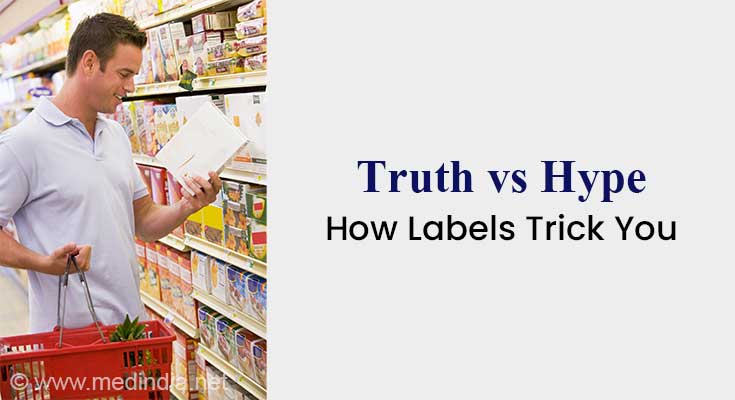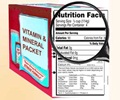- Consumer Knowledge about Food Labeling and Fraud - (https://pmc.ncbi.nlm.nih.gov/articles/PMC8156633/)
- Fruit-related terms and images on food packages and advertisements affect children's perceptions of foods' fruit content - (https://pubmed.ncbi.nlm.nih.gov/25850443/)
- Eating, Diet, & Nutrition for Celiac - (https://www.niddk.nih.gov/health-information/digestive-diseases/celiac-disease/eating-diet-nutrition#)
About
Products that boast of being "sugar-free," "light," "low-calorie," "natural," "organic," and a host of other alluring healthy attributes are plentiful in the middle aisles of any grocery store. However, what are the true meanings of these claims? Do they have any significance? Does a discriminating consumer need to pay extra attention to any specific food labels?
The Food and Drug Administration (FDA) has established criteria for several of these claims in the US. Others, however, have little to no instructions on how to utilize them.
Did You Know?
A product labeled "Zero Trans Fat" can still contain up to 0.5 grams per serving! Multiply that by multiple servings, and it's not zero at all! #foodlabels #hiddenfacts #medindia
What are Misleading Labels?
Companies want to meet the minimum requirements that regulate their packaging and contents, but they also want customers to pick up their products and buy them. This is the dual goal of food labeling. The over $14 billion that food, beverage, and restaurant firms spend annually on marketing helps to further support the second purpose. Companies try to employ trigger words that describe flavors, ingredients, and their sources to draw in customers, which is the primary cause of false labeling. The goal is to sell more items.
Can Food Labels Give False Information?
Unfortunately, as a sales ploy, food labels often utilize cleverly worded language that both attracts and misleads people. The COVID-19 pandemic has raised consumer interest in eating healthily. Plant-based eating is becoming more popular as a result of consumers' increased preference for plant-based foods as well as growing interest in gut health and eating for mental wellness. In order to make sure that their products draw in more customers than their rivals, food producers and marketing firms consider these trends and preferences while creating food labels(1✔ ✔Trusted Source
Consumer Knowledge about Food Labeling and Fraud
Go to source).
Why are Food Labels Inaccurate?
More sales result from overstating a food product's advantages on the label in a way that encourages consumers to buy it. It may be sufficient to simply touch a product to give a customer a feeling of ownership and boost the possibility that they would purchase it. Food marketers understand the value of appealing packaging and monitor customer buying patterns to make sure their strategies reflect the most recent findings on consumer demand. These trends influence the creation of food labels.

Top 13 False Statements on Food Labels
Because different trigger phrases used on packaging are subject to different rules, reading food labels can be difficult. While some commonly used label claims have no regulatory guidance at all, others are subject to strict regulations about the product's contents.
1. The Sugar-Free Label
Guidelines are provided by the Food and Drug Administration (FDA) for a number of common product labels, such as sugar-free. Although the name implies that goods bearing this label would be sugar-free, a single serving size may contain as much as 0.5 grams of sugar(1✔ ✔Trusted Source
Consumer Knowledge about Food Labeling and Fraud
Go to source). Sugar-free products, Cereals may also contain more fat to compensate for the flavor and texture that are lost when sugar is eliminated.
2. Fruit-Flavored Label
When a product is labeled as fruit-flavored, it implies that actual fruit is used to flavor it. However, this isn't always the case. Usually, however, these items are treated with chemicals that give them a fruity flavor. Additionally, keep in mind that the FDA has no regulations governing the amount of fruit that must be included in products bearing the term "made with real fruit," therefore a product bearing this label does not always contain any real fruits(2✔ ✔Trusted Source
Fruit-related terms and images on food packages and advertisements affect children's perceptions of foods' fruit content
Go to source).
3. Gluten-Free Label
The FDA published a final rule in 2013 that defined "gluten-free" and provided guidelines for its application. A product must have fewer than 20 parts per million of gluten in order to be labeled gluten-free(3✔ ✔Trusted Source
Eating, Diet, & Nutrition for Celiac
Go to source). Manufacturers of gluten-free foods are not obligated to use the label because it is optional.
4. Light Label
Foods with the designation "light" just need to be compared to the average of that kind of food; they are not required to meet any standards on their own. For instance, light bread only needs to be superior to regular bread; it doesn't need to meet specific calorie, fat, or cholesterol content requirements.
5. Low-Calorie Label
According to the FDA, items must have 40 calories or fewer per reference amount usually eaten (RACC) in order to be labeled low-calorie in the US. There should be no more than 120 calories per 100 grams of food in meals and main courses(1✔ ✔Trusted Source
Consumer Knowledge about Food Labeling and Fraud
Go to source).
6. Low-Carb Label
When it comes to identifying items as low-carb, the FDA has no rules. The label can therefore be used for almost any product.
7. Low-Fat Label
The FDA regulates the use of the term "low-fat," stating that products cannot have more than 3 grams of fat per 50 grams(1✔ ✔Trusted Source
Consumer Knowledge about Food Labeling and Fraud
Go to source). Foods for meals and main courses should have no more than 3 grams of fat per 100 grams, and fat cannot account for more than 30% of calories.
8. Made with Whole Grains Label
Even if a food is predominantly composed of refined grains, or grains that have been crushed into flour, food manufacturers and packagers can nevertheless claim that the dish is produced with whole grains.
9. Multigrain Label
Although the word "multigrain" might conjure up an image of several nutritious whole grains combined into a single product, this is probably not the case. The phrase simply indicates that the cuisine was made from a variety of grains, most of which are probably refined.
10. Natural Label
When it comes to food marketing, the phrase "natural" has no particular definition. Rather, the term is exploited to make assumptions from well-intentioned buyers who are looking for goods without artificial components.
11. No Cholesterol Label
The FDA states that foods advertised as cholesterol-free, whether they are snacks or meals, cannot include more than 2 mg of cholesterol per serving size(1✔ ✔Trusted Source
Consumer Knowledge about Food Labeling and Fraud
Go to source). When food is labeled as cholesterol-free, consumers may assume that its constituents are cholesterol-free. This is not always the case, though, as substances that contain cholesterol can be included in foods that are cholesterol-free as long as they are identified as such on the label.
12. Organic Label
Foods must meet certain very tight standards in order to be classified as organic, such as utilizing only a limited number of permitted herbicides and fertilizers to promote growth. Nonetheless, people often believe that food items with this phrase on the package are healthier or of higher quality than their non-organic counterparts.
13. Zero Trans Fat Label
Foods labeled as having no trans fat may actually have as much as 0.5 grams per serving(1✔ ✔Trusted Source
Consumer Knowledge about Food Labeling and Fraud
Go to source). The quantity of trans fat consumed can be rapidly increased by eating multiple servings.
How to Avoid Being Tricked When Reading Food Labels
Despite the numerous attempts to use misleading labeling to fool customers into buying products, there are a few easy measures that consumers can take to make wise choices when they are at the grocery store.
Ignore Food Packaging Claims on the Front
Customers can avoid being duped by generally ignoring the claims on the packaging, which are presented in bold, bright lettering. These assertions frequently rest on legalese and technicalities that might be deceptive and unworkable.
Examine the Ingredient List
Flip the product over and review the contents list and nutritional data before making a purchase. Are added sugar, cholesterol, or sodium levels too high? What are the first few items listed in the ingredients list? Since the ingredients are listed in descending order, these comprise the majority of the food items. Whole foods mentioned as the first few components are probably healthier than those that contain sugars or refined grains.
Be Aware of Serving Sizes
Because of their small serving size, some foods may appear low in calories, salt, added sugar, and other important nutrients on the nutrient list, but they aren't. The nutrition label for many cookies is based on serving sizes of one to three cookies, although many cookies have significantly higher quantities, which makes eating much simpler. For this reason, consider serving size when evaluating a food's nutritional worth.
How to Interpret the Sugar Content on Food Labels?
The sugar content is arguably one of the most perplexing items on a food label. A wide range of substances, such as fructose, dextrose, and high-fructose corn syrup, are categorized as sugar. Understanding the various forms that sugar can take in food is crucial when understanding a label's sugar content.
Sugar Types
On food labels, sugar is referred to by at least 56 different names. Glucose and/or fructose make up each type of sugar. The body metabolizes the two in different ways; nearly every cell in the body metabolizes glucose, while the liver metabolizes fructose exclusively.
Different Kinds of Syrup
High-fructose corn syrup is arguably the most common form of sugar syrup present in processed foods. High-fructose corn syrup is made from broken-down corn starch and typically contains around 50% fructose. The FDA does not see any distinction between high-fructose corn syrup and other sweeteners in terms of safety.
Additional Added Sugars
Consuming excessive amounts of sugar can cause diabetes, heart disease, weight gain, and other health issues. Since natural sugar found in fruits and vegetables contains fiber that inhibits its absorption into the body, added sugar is the most unhealthy form of sugar consumption. Almost all processed foods contain sugar, which can be identified in food ingredient lists by looking closely for components that finish in "-ose."
A Simple Fix?
Making healthy food choices at the grocery store can be difficult, particularly when the typical consumer is competing with a multibillion-dollar marketing business that is skilled at deceiving customers and selling goods. Avoiding processed foods completely and focusing on whole foods and plant-based foods, such as goods manufactured with 100% whole grains, fruits, and vegetables, is one of the greatest methods to make sure you're eating a healthy diet.









